Welcome to The Art Room: Where mental health meets creativity in Denton
By Hope Alvarez
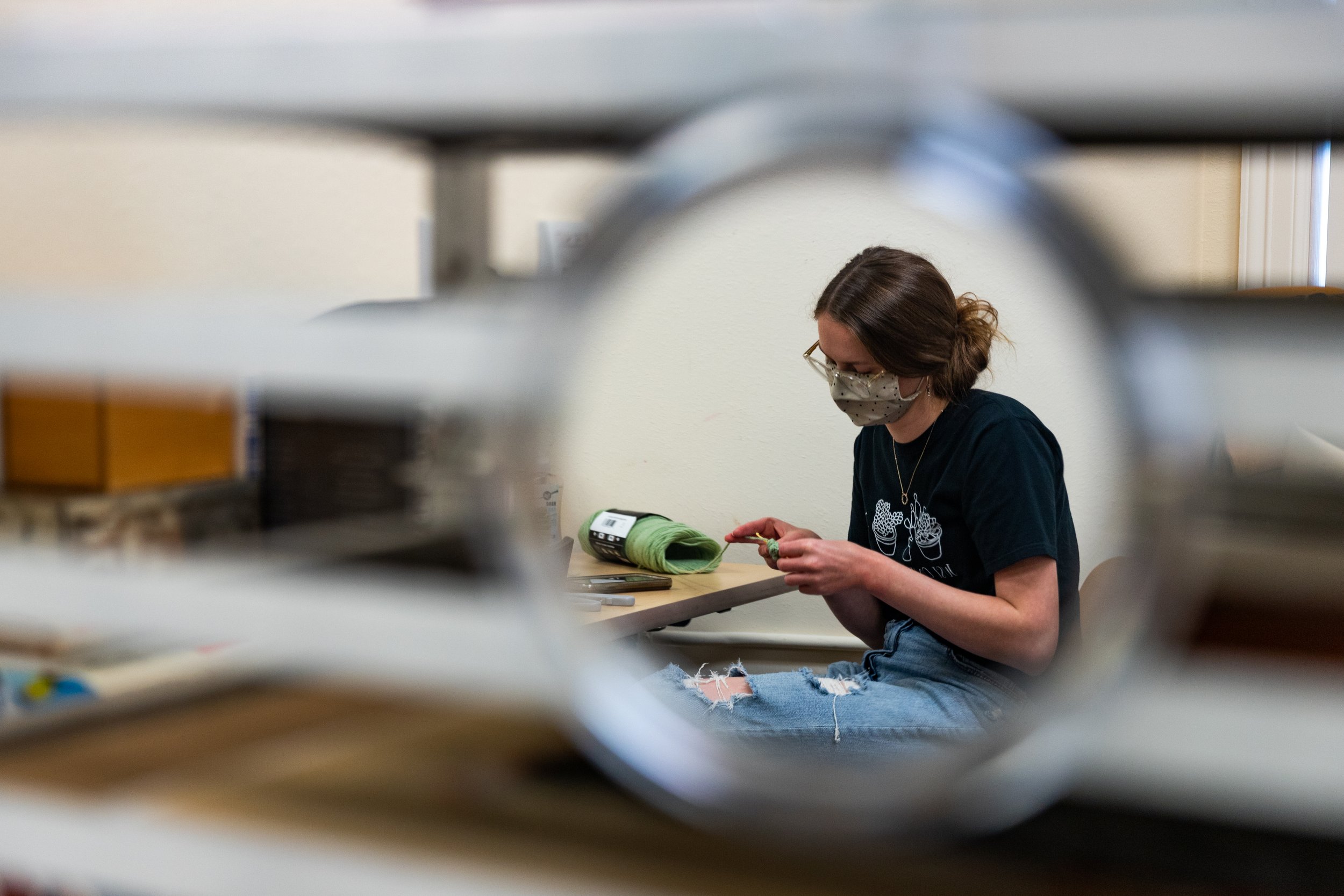
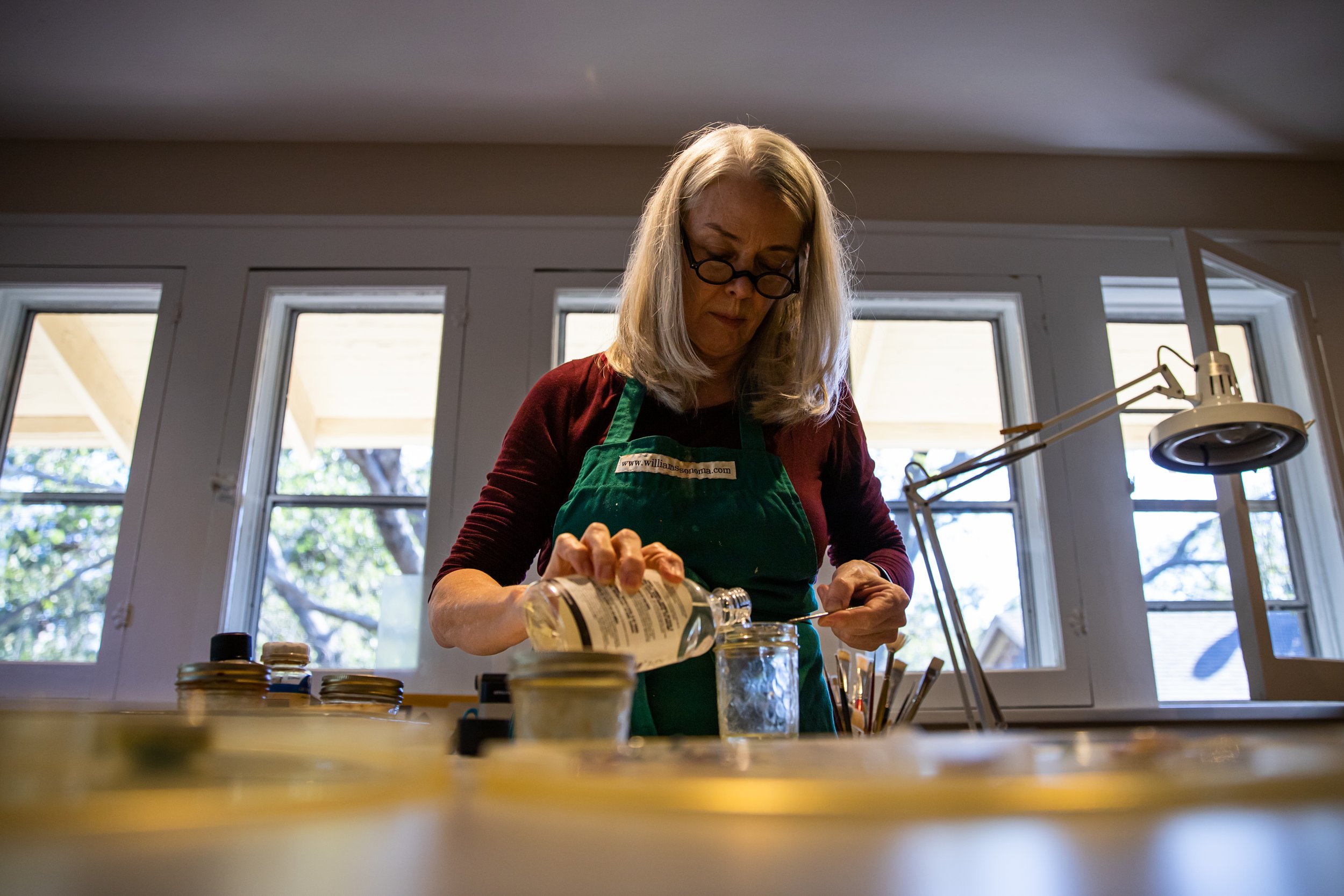
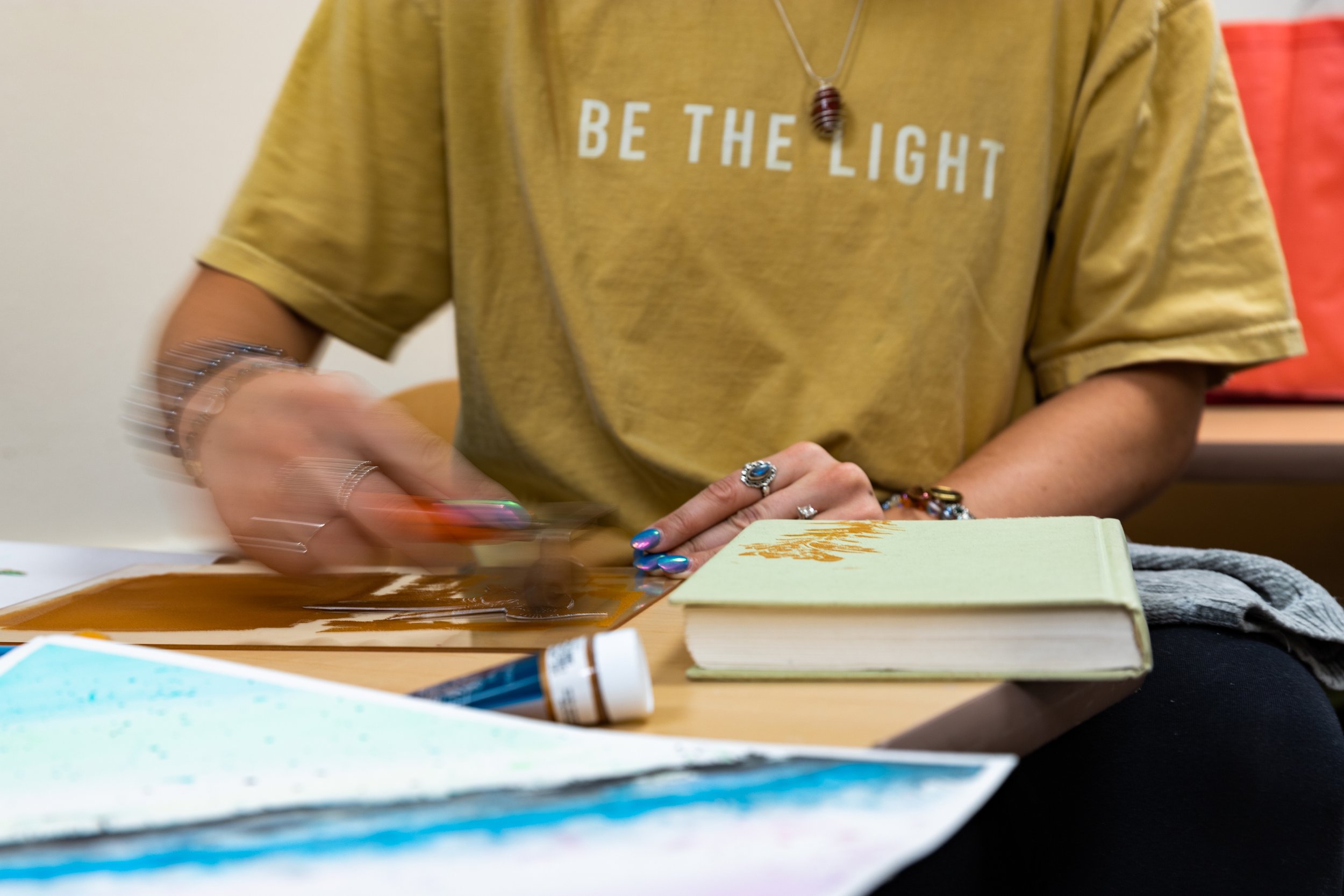
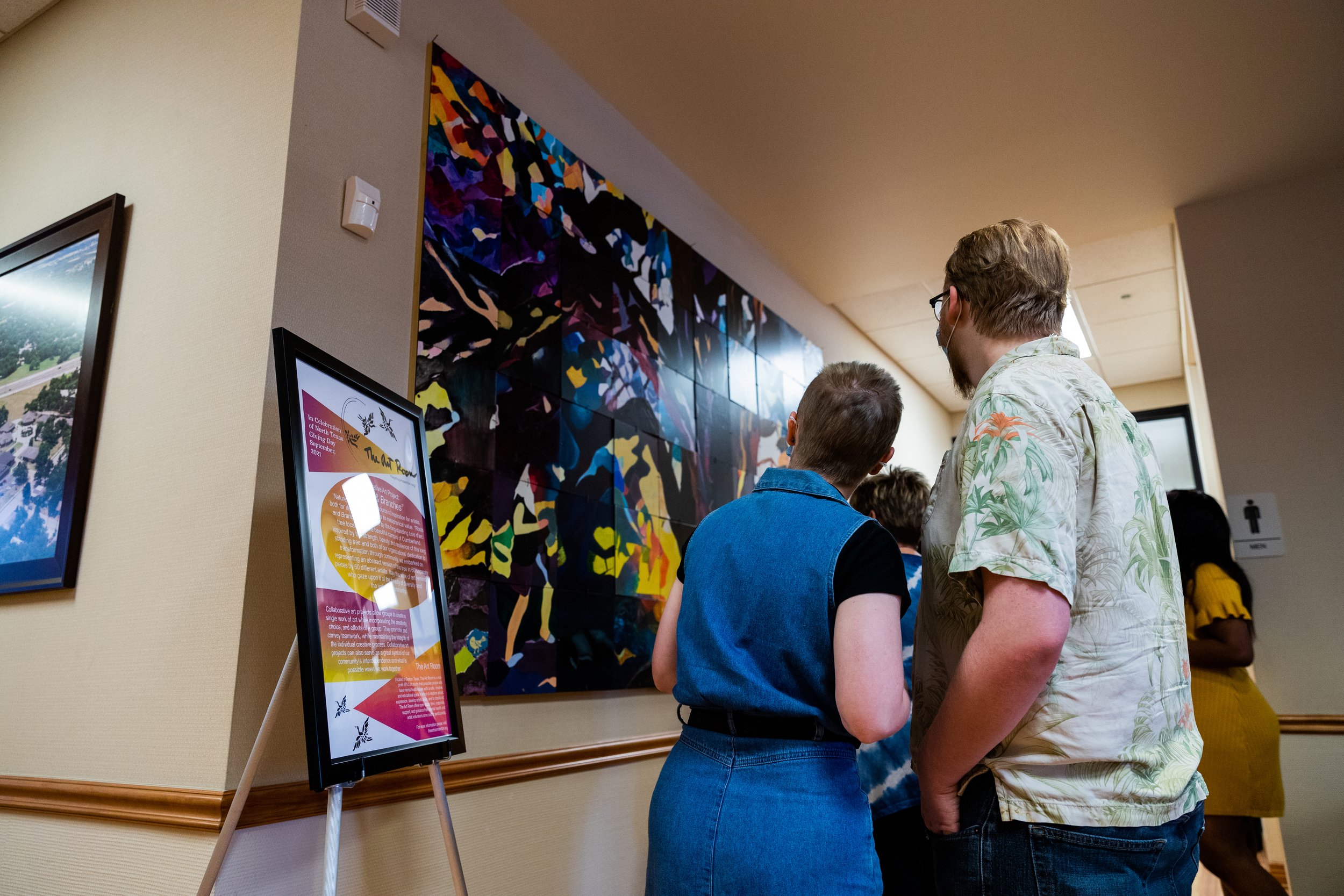
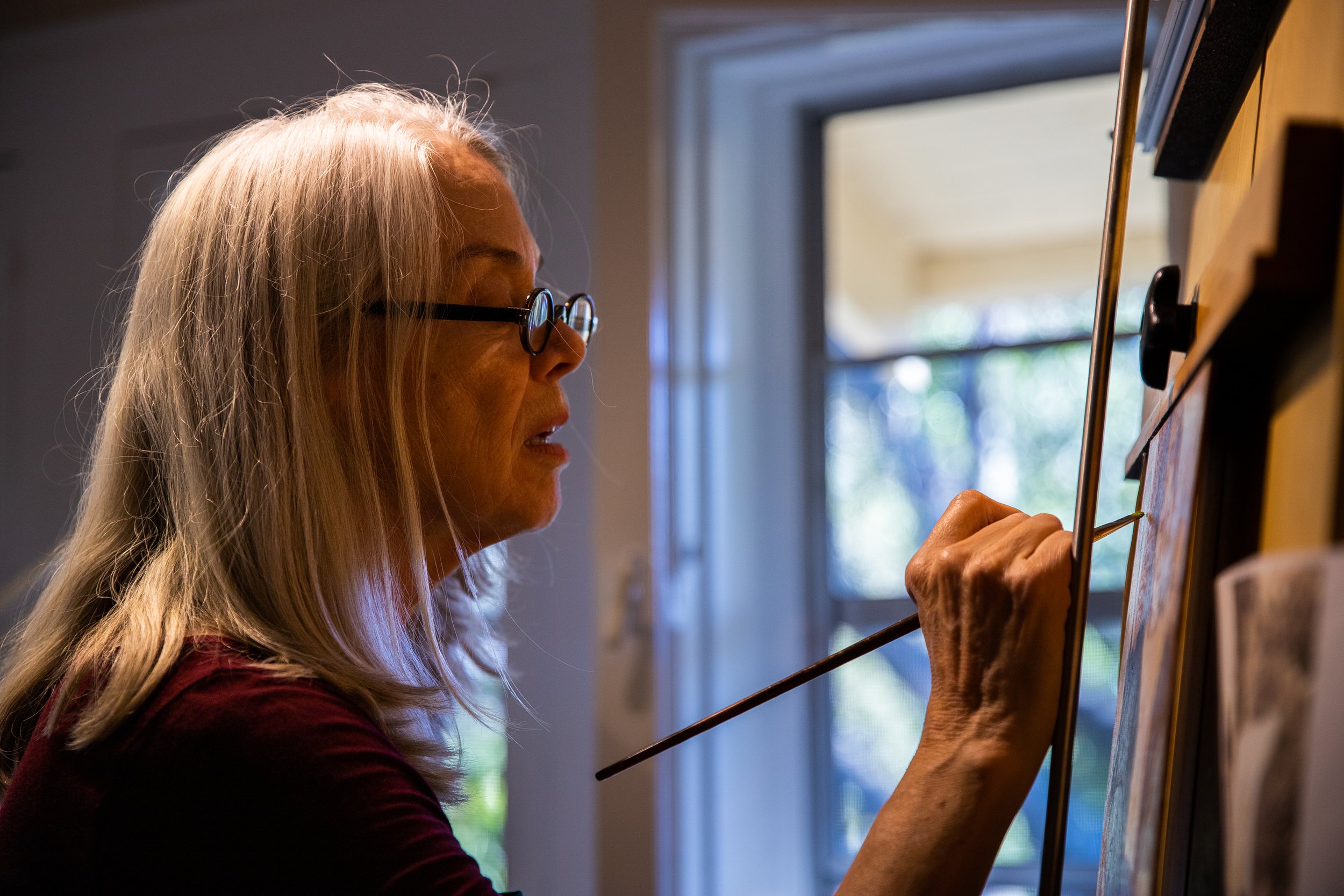
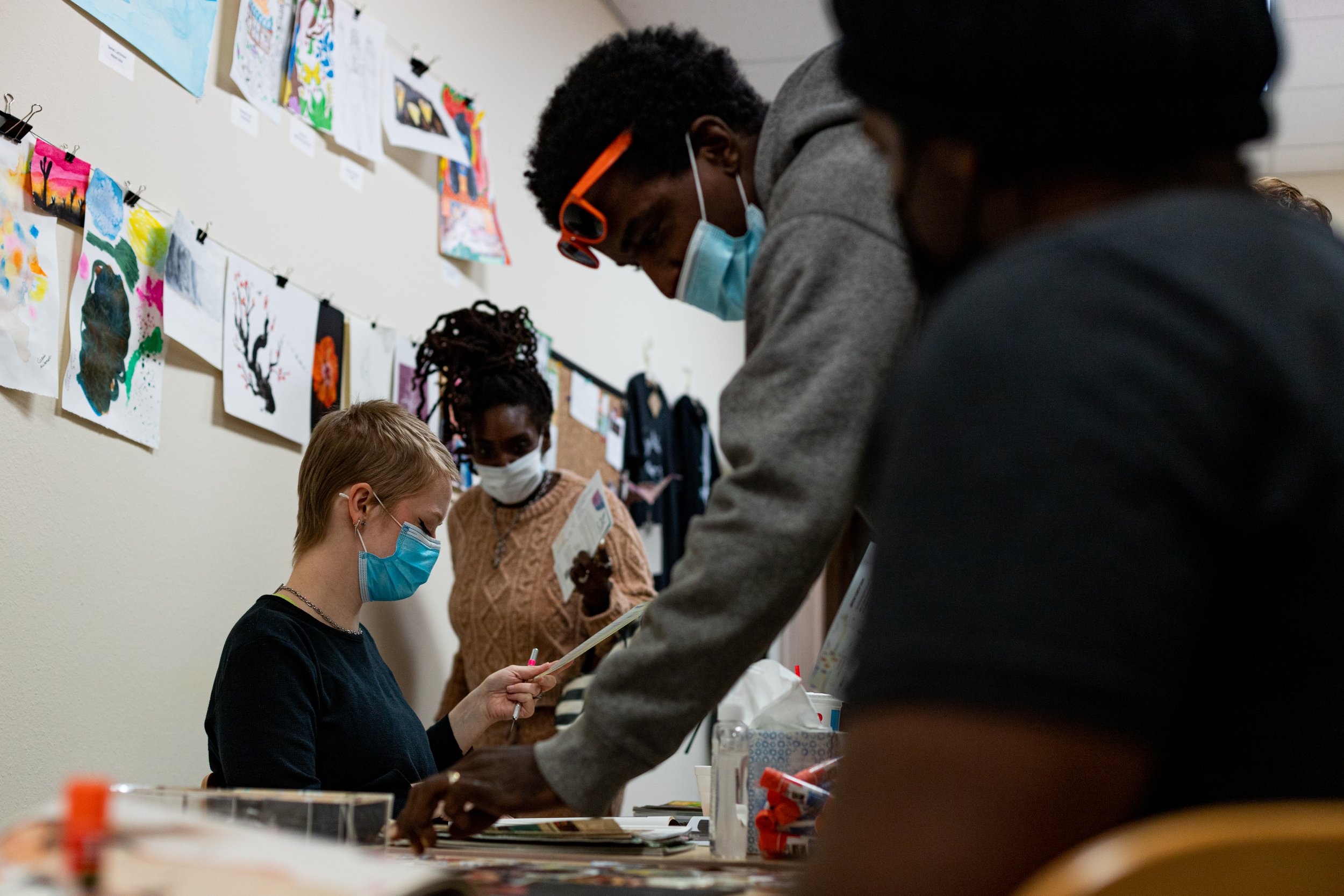
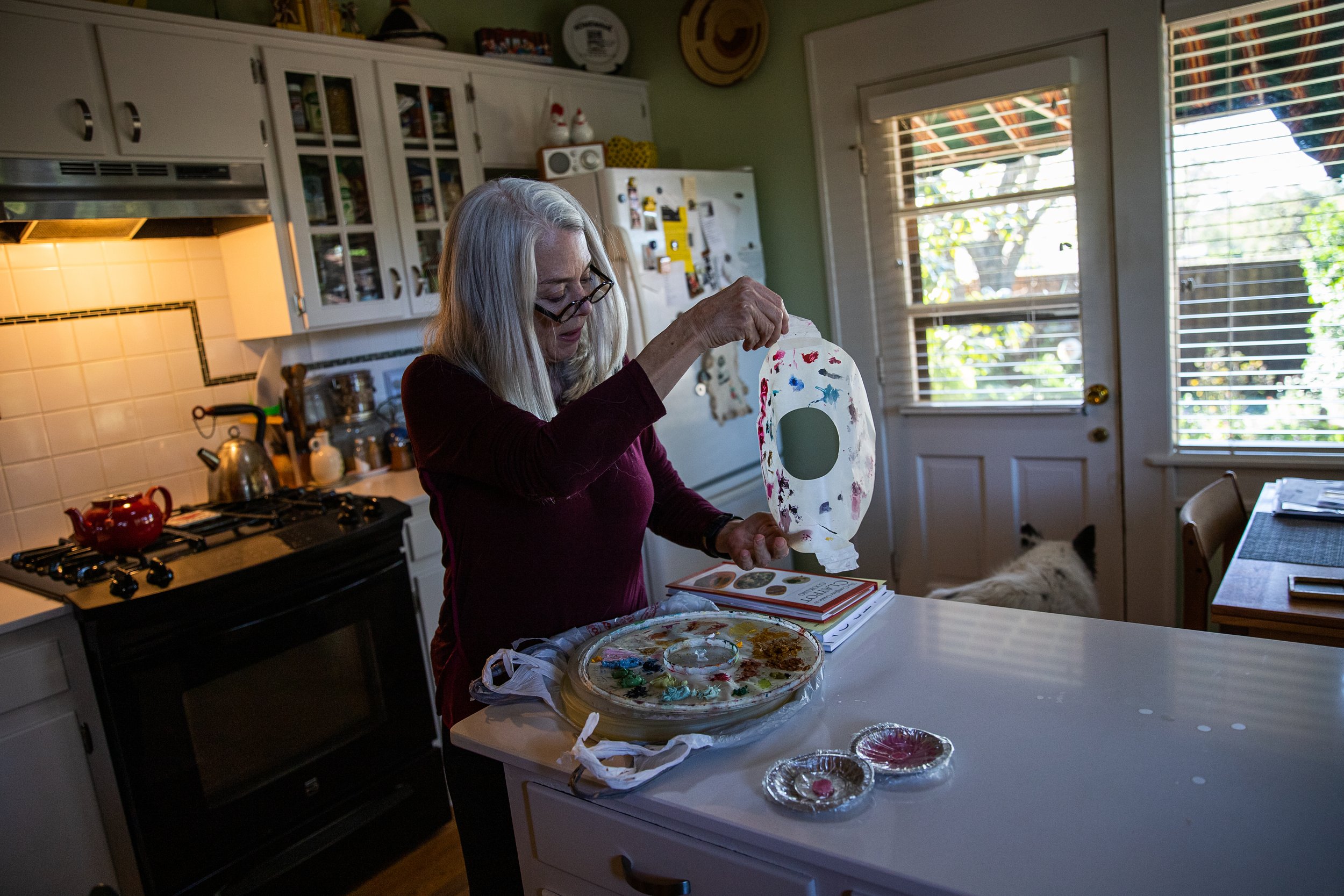
The aroma of paint thinner lingers in the narrow hallway tucked behind a bakery in Denton. A chorus of whirling fans attempts to aerate the space on a warm fall afternoon. It doesn’t usually smell this strong, but mistakes happen when creativity is buzzing.
Around the corner is a tall, slender man, carefully dabbing the paint thinner on a black sheet of paper. He’s reconstructing the landscape of the rolling hills he has sketched with white oil pastels.
Marlys Lamar, founder of The Art Room, instructs the man on how to use the paint thinner and assures him that mistakes are inevitable in the creative process.
The bell rings as the door to the hallway opens. Another woman shuffles in. She heads over to the ceiling-to-floor bookshelf and selects various shades of orange acrylic paints. On the table next to her, she uncoils a ball of cheap beaded necklaces, fills a cup of water and gets to work. She drags the beads across a pool of coral paint and washes them in the cup to reset.
The smell of the paint thinner partially subsides.
“I thought the fans would help,” Lamar says as she observes the group concentrating on their artwork. Her hope is that the peaceful atmosphere of the space will enable those in the room to paint their anxiety away.
Lamar walks to a computer and selects her curated Spotify playlist, instrumentals mixed with classical string instruments and electronic lo-fi sounds. Soft piano music trickles out of the speakers as she enters her office through the rear door. Despite wanting to be near the artists and their art, she needs to prepare for another fundraising meeting, which keeps The Art Room going and allows the Denton community to explore mental health through the medium of art.
Lamar is the founder of The Art Room, which since 2019 has provided a space for Denton residents to explore their creativity as a means of coping with the anxieties wrought by their mental health struggles. As a psychologist, Lamar has seen the therapeutic benefits of employing art to regulate emotions.
“It reduces stress hormones, and it improves your dopamine,” Lamar says. “There’s something about art making, the absorption that happens when you do art.”
In 2017, Lamar moved her private psychology practice into a space connected to Ravelin Bakery off Elm Street. A psychologist first and an artist second, Lamar felt compelled to weave her two passions together and create a space for self-guided art therapy.
“I know how it feels for me to create, so I just thought it’d be really great to have an open studio,” Lamar says. “Oftentimes you don’t think it means that much, but all art is autobiographical.”
Art and the mind
From a young age, Lamar knew the importance of processing emotions. After her father was called up to fight in the Vietnam War, she became a rebellious military brat in Little Rock, Arkansas, where she caused mischief during her father’s seven-year absence.
Worried about her daughter’s mental health, Lamar’s mother steered her to a psychiatrist. But Lamar was skeptical. She didn’t believe a stranger could help her comprehend her 16-year-old emotions, so she first sat in on her mother’s therapy appointment.
In a dimly lit room under the buzz of fluorescent lights, Lamar slouched in the wingback chair, anticipating an hour of boredom. Instead, she discovered another side of her mother. She was more than just a maternal figure, not just someone who grounded her daughter if she didn’t return by curfew. Lamar watched her mother unleash a smorgasbord of emotions that were kept bottled up until it was time to analyze the cluttered chaos in her head.
It was in this room where Lamar finally accepted that she could explore her own emotions without feeling guilty. It was a place to feel sorrow, anger, even happiness. While the clock ticked, Lamar was free to express herself without judgment.
After attending several routine therapy sessions, Lamar became enthralled with the inner workings of the mind. By 17, she knew she wanted to become a psychologist, replicating the same sanctuary she had experienced, a place where her patients wouldn’t have to worry about being criticized, a place where all emotions were treated as valid.
Lamar attended the University of Texas, graduating with an undergraduate degree in psychology. In 1986, she obtained her doctorate in psychology at what was then known as North Texas State University. Lamar established her private practice in Carrollton in 1988, then moved to Denton 16 years later. Hoping to understand the therapeutic benefits of art, Lamar enrolled as a non-degree-seeking art student at Texas Woman’s University.
With a lifelong passion for art, its connection to her practice didn’t occur to her until 2002, when in her late 40s, she went on a study-abroad trip to Ballyvaughan, a quaint village off the coast of Ireland. But Lamar felt like an impostor. She wasn’t pursuing a degree and was surrounded by graduate students who immersed their lives in art. She was just searching for ways to improve her psychology practice.
While the graduate students remained in the confines of art studios, Lamar hitched a ride on a rented bike and painted where she felt inspired. It was among Ireland’s rolling hills and seashore that she realized the relationship between art and the mind. She imagined a physical place with unlimited art supplies, where a community could gather and turn emotions into art.
Birth of The Art Room
It’s 2017, and Lamar is ready to make The Art Room a reality. After marinating on the idea for years, she found a former photography studio to lease, still decked out with artwork on the walls and computers lining the counters. But Lamar could sense the creativity in the room. This was the place she would launch her nonprofit.
The Art Room began with a three-hour meeting with its future vice president, Maryam Flory, a Denton County MHMR counselor. The two cultivated the materials needed to get the studio up and running, being sure to follow Flory’s “steps to actualization.”
They compiled what seemed like a never-ending list, but Flory assured Lamar it was possible. The art supplies, the volunteers — they would all fall into place.
“I really loved the idea because resources like this are rarely available for individuals with mental health issues,” Flory says. “It means an opportunity to build resilience and an opportunity to explore our creativity.”
A website and an open house conveyed the nonprofit’s message to counselors and artists, but Lamar realized the value of The Art Room to the community when she promoted its opening in 2019 at a Sarah Jaffe concert in Denton.
A packed crowd chattered at Dan’s SilverLeaf while Lamar sat backstage with Jaffe. Full of jitters, Lamar anxiously awaited her cue to go on stage.
“I’m so nervous,” she whispered to Jaffe. “I hope I can even speak.”
The audience erupted in applause as Lamar took the stage. Potential funders and volunteers immediately showed interest. As names and numbers swiftly covered the sign-up sheet, Lamar felt The Art Room would soon transform her life.
After the nonprofit’s official opening in 2019, local artists donated their finest art supplies, which lined the studio’s walls. The Art Room requires no official mental health diagnosis for membership. All members are welcome to come and use what they desire. There’s no fee to use the studio or its supplies. Adult Denton County residents can just grab a bundle of art supplies and begin creating.
‘A place to have fun’
It’s June 2021, and The Art Room’s newest member is Aquira Bayo. She arrives for a new member orientation with Lamar, who provides a guided walk-through of the art studio and materials offered.
“Do you have a sketchbook?” Lamar asks.
Unsure if a notebook of raggedy papers stitched together qualifies as a professional sketchbook, Bayo hesitates to answer.
“If you can call it that, then sure,” she says.
Her eyes beam as Lamar pulls out a new sketchbook. With the inside of the pages so clean, Bayo can’t wait to christen it with art. Tears well up in her eyes, astounded that a stranger is being so kind.
“It’s so nice to have somebody give me something and feel like, ‘This is yours now. Feel free to create with it however you want,’” Bayo says.
Two months later, Bayo returns to The Art Room, the sketchbook clutched in her hand.
“I remember it was a really big moment for me,” Bayo recalls. “I had a really rough day. I didn’t feel like talking to anyone, but it was so weird because by the end of it, I was talking to everybody. It was like something out of a movie.”
It’s the little moments of gifting sketchbooks and new conversations that spark magic within The Art Room. Hope feels alive as members run paintbrushes under the cold water in the portable hand-washing sink, ready to tackle a new project.
“I always get inspired by seeing the artwork other people are doing,” Lamar says. “It just means, for me, a place to really find yourself in a good space, a space where you can kind of use a different part of your brain. Maybe a part of the brain that’s a little less anxious, less worried. A place to have fun.”
‘A lot of hope’
It’s another Friday evening in November for The Art Room, but instead of closing the doors after open studio hours, The Art Room staff puts the tables together assembly-line style to prepare for their fundraising community event. This time it’s an art workshop, and button-making is on the agenda tonight as Lamar and her crew spread awareness about the nonprofit organization.
Apple cider boils in a Crockpot while a line of people shuffle into The Art Room. The faint sound of mingling begins to build, and scissors scrape against pages of magazines. Lamar takes a sip of wine as she explains what The Art Room has to offer: community, acceptance and expression. Emma Manley, The Art Room’s administrative assistant, greets more people as they walk through the door munching on Lamar’s homemade brownies.
“Just being able to see so many different people come in and all the different mindsets they have,” Manley says. “All the different forms of creativity they can bring into The Art Room. There’s a lot of hope.”
At the do-it-yourself arts and crafts station, a sense of nostalgia whirls around the room, eliciting sentiments of “oohs” and “aahs” typical of a kindergarten art lesson. Origami cranes float across the ceiling. Lamar steps back to scan the room and admire what she’s created. People are packed tight, smiles plastered across their faces, something she didn’t expect to see when the room was once a skeleton.
Lamar’s fundraising meeting is over now. She can be where she wants to be, watching members dip their hands in buckets of oil pastels and sifting through various art education books.
With only a few minutes left in the open studio, she takes it all in: the smell of pesky paint thinner, the sound of pencils sharpening, the sight of the beads dancing across the acrylic paint. Creativity is alive in The Art Room.